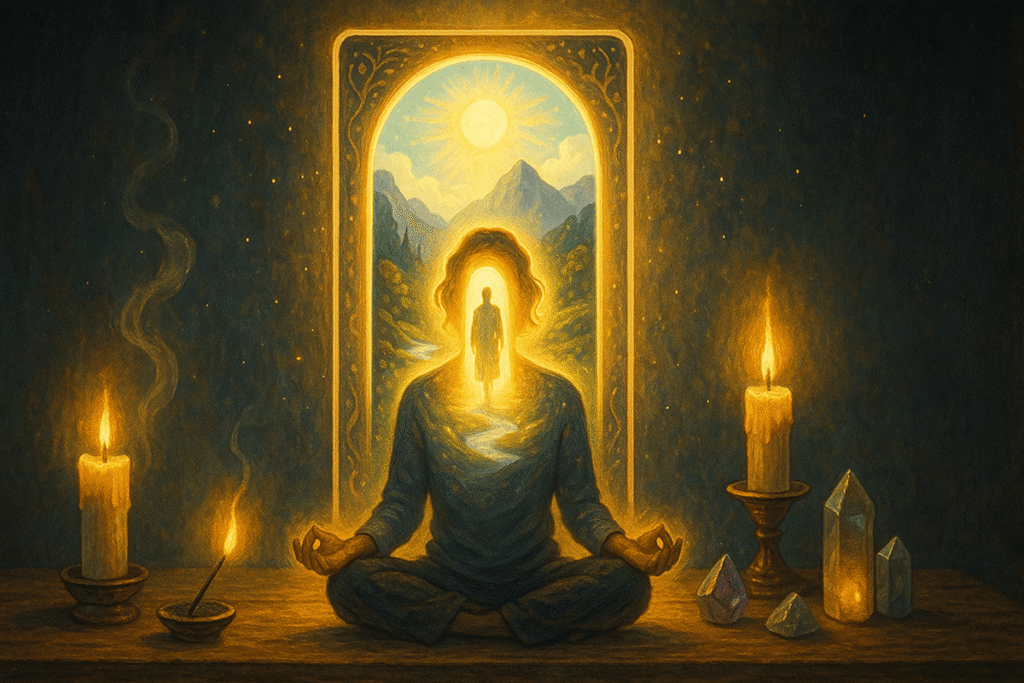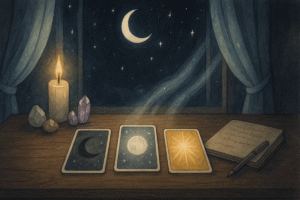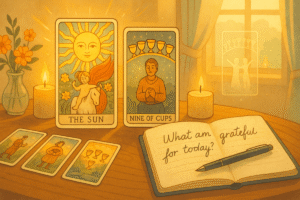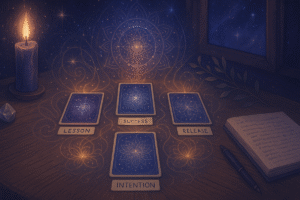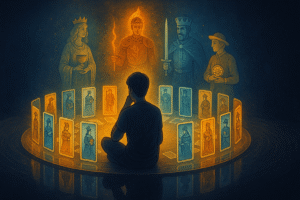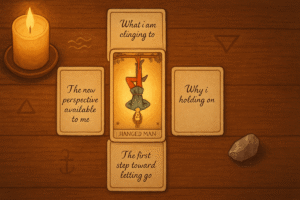Table of Contents
There’s something almost magical about holding a tarot card and really seeing it for the first time. Not just glancing at the imagery or memorizing traditional meanings, but actually allowing yourself to step into that small rectangle of artistry and symbolism. I’ve found that when we meditate on a tarot card, we’re doing something far more profound than studying it. We’re creating a bridge between our conscious mind and the deeper wisdom that lives in symbols, colors, and archetypal imagery.
The practice of meditating on tarot cards has become one of my favorite ways to deepen self-reflection. It’s not about fortune telling or predicting the future. Instead, it’s about using these beautifully crafted images as doorways into our own inner landscape. When we learn to truly meditate on a tarot card, we’re essentially learning to have a conversation with our subconscious through visual language.
Understanding Card Meditation as a Reflective Practice
Card meditation differs significantly from traditional tarot reading. While readings often focus on interpretation and meaning, meditation invites us into experience. Think of it this way: reading about a forest and actually walking through one are completely different experiences. The same applies here. When we meditate on a card, we’re not asking what it means. We’re asking what it feels like to be present with it.
This practice draws from mindfulness traditions that have been around for centuries. The idea of using visual focus points for meditation isn’t new. Tibetan practitioners have long used mandalas, while other traditions employ candle flames or natural scenes. Tarot cards, with their rich symbolism and carefully composed imagery, serve as perfect modern mandalas for contemplative practice.
What makes this particularly powerful is how it shifts our relationship with the cards themselves. Instead of seeing them as external tools that give us information, we begin to understand them as mirrors that reflect our own inner wisdom. The insights we gain don’t come from the card telling us something. They emerge from the space we create when we allow ourselves to be fully present with the imagery.
Preparing Your Space for Deep Reflection
Creating the right environment for card meditation matters more than you might initially think. I’ve tried this practice in noisy coffee shops and quiet bedrooms, and the difference is remarkable. You don’t need a perfect setup, but a few simple preparations can dramatically enhance your experience.
Find a spot where you won’t be interrupted for at least fifteen to twenty minutes. This might be longer than you expect to spend, but deep meditation has its own rhythm. Sometimes the most profound insights come just when we think we’re ready to finish. Turn off your phone or at least put it in another room. The temptation to check messages can pull you right out of the meditative state.
Lighting plays a surprisingly important role. Natural light works beautifully if you’re practicing during the day. The way sunlight hits the colors in tarot artwork can reveal details you’ve never noticed. If you’re practicing in the evening, soft lamp light creates an intimate atmosphere that helps you settle into the contemplative mood.
Some people like to light a candle or burn incense, and while these aren’t necessary, they can help signal to your mind that you’re transitioning into a different kind of awareness. I personally find that a small cup of tea nearby helps me feel more grounded, though this might just be my own quirky preference.
The position you choose for sitting matters too. You want to be comfortable enough that physical discomfort doesn’t distract you, but alert enough that you don’t drift off to sleep. I usually sit in a comfortable chair with the card propped up at eye level, though some people prefer sitting on the floor with the card on a low table.
Choosing Your Card Mindfully
The card selection process itself can be meditative. Rather than randomly picking or deliberately choosing your favorite, try this approach that I’ve developed over time. Shuffle your deck slowly, paying attention to the feel of the cards in your hands. Notice the weight, the texture, the slight sound they make as they move against each other.
When you feel ready, stop shuffling. Don’t overthink this moment. Your intuition knows when to pause. Some days this happens after just a few shuffles, other times you might shuffle for several minutes. There’s no right or wrong timing.
Now, instead of immediately drawing a card, take a moment to set an intention. This doesn’t need to be elaborate or deeply spiritual. Simply invite yourself to be open to whatever card wants to work with you today. You might think something like, “I’m ready to explore and learn,” or simply, “I’m open to this experience.”
Draw your card and place it face down in front of you without looking at it yet. Take three deep breaths. This pause creates a small ceremony that helps your mind transition from everyday thinking into contemplative awareness. When you’re ready, turn the card over.
Your first reaction to seeing the card is valuable information. Notice if you feel pleased, disappointed, confused, or curious. Don’t judge these reactions, just acknowledge them. Sometimes we resist certain cards because they represent aspects of ourselves or our lives that we’d rather not examine. This resistance itself can become part of your meditation.
The Visualization Journey Begins
Now comes the heart of the practice. Position the card where you can see it clearly without straining. Begin by simply looking at the overall image. Let your eyes soften slightly, the way you might look at a beautiful sunset. You’re not analyzing or studying. You’re receiving.
Start to notice what draws your attention first. Is it a particular figure, a color, an object, or perhaps the background? There’s no need to force focus on any specific element. Let your natural curiosity guide you. I often find that my attention moves around the card in unexpected patterns, sometimes returning again and again to details I initially overlooked.
As you continue gazing at the card, begin to imagine that you’re standing at the edge of the scene, as if looking through a window into another world. What would the temperature be like in this place? Is there a breeze? What season does it feel like? These questions aren’t tests with correct answers. They’re invitations to engage your imagination and intuition.
Now, here’s where the practice becomes truly immersive. Imagine stepping into the card. Picture yourself crossing from your physical space into the world depicted in the image. What does the ground feel like under your feet? If there are figures in the card, how do you relate to them? Are you an observer, a participant, or perhaps you become one of the figures yourself?
Engaging All Your Senses
Once you’ve imaginatively entered the card’s world, begin to explore it with all your senses. This multisensory approach is what transforms a simple visualization into a rich, memorable experience. Start with what you can see, but look beyond the obvious details.
Notice the quality of light in this space. Is it the golden light of sunset, the cool blue of dawn, or perhaps the mysterious glow of moonlight? How do shadows fall? Are there textures you hadn’t noticed before when simply looking at the card from outside?
Turn your attention to sounds. This might feel strange at first since tarot cards are silent images, but let your imagination fill in the auditory landscape. If there are animals present, what sounds might they make? Is there wind rustling through trees, water flowing, or perhaps the distant sound of music or conversation?
What about smells? The scent of flowers, earth after rain, ocean air, or wood smoke can add incredible richness to your meditative experience. These imagined sensory details help create what psychologists call “embodied cognition,” where your body-mind system responds as if you’re actually having these experiences.
Physical sensations are equally important. How does the air feel on your skin? Is it warm, cool, humid, dry? If you touch objects in the card’s world, what do they feel like? Smooth stone, rough bark, soft fabric, or cool metal? The more fully you can imagine these sensations, the more present you become in the meditative space.
Having Internal Conversations
Perhaps the most revealing aspect of card meditation comes when you begin to engage with the figures or symbols in the card as if they’re alive and aware. This might sound unusual if you’ve never tried it, but it’s a powerful technique used in various therapeutic and spiritual traditions.
If there’s a person in your chosen card, try having a conversation with them. What would you want to ask? How do they respond? You might be surprised by the wisdom that emerges from these imagined dialogues. The responses don’t come from the card, of course. They arise from deeper parts of your own psyche that often go unheard in daily life.
Even if your card doesn’t feature human figures, you can still engage in dialogue. A tower might represent structure and stability in your life. What would it say about foundations that need attention? A flowing river might speak about the areas where you need more flexibility or movement.
Sometimes I find myself becoming different figures within the same card during a single meditation. This shape-shifting quality of the practice can offer multiple perspectives on whatever situation or question I’m contemplating. There’s something liberating about temporarily stepping into different archetypal roles and seeing through their eyes.
These conversations often reveal insights that surprise me. It’s as if different aspects of my consciousness get to speak up when given this symbolic framework for expression.
Deepening Your Practice Over Time
The beauty of tarot card meditation lies in how it evolves with regular practice. A card that felt mysterious or even uncomfortable initially might become a trusted teacher over time. I’ve had cards that I returned to again and again over months, each session revealing new layers of meaning and connection.
Consider keeping a meditation journal specifically for these experiences. Not a detailed analysis, but simple notes about what you experienced, how you felt, or any insights that emerged. You might write something like, “The figure in the card seemed sad today, and I realized I’ve been ignoring my own need for comfort” or “The colors felt more vibrant than usual, and I left feeling energized.”
Some practitioners develop relationships with specific cards that become go-to meditation partners. There’s nothing wrong with having favorites, though I’d encourage you to occasionally challenge yourself with cards that don’t immediately appeal to you. Often these reluctant partnerships offer the most growth.
You might also experiment with different meditation lengths. Some days, five minutes feels perfect. Other times, you might find yourself in contemplative conversation with a card for thirty minutes or longer. Let your natural rhythm guide you rather than forcing a predetermined timeframe.
Integrating Insights into Daily Life
The real value of card meditation lies not just in the experience itself, but in how those insights weave into your everyday awareness. After each session, take a moment to consider what you’ve discovered. Not necessarily profound spiritual revelations, but perhaps small shifts in perspective or gentle reminders about aspects of life that deserve attention.
You might notice that themes from your meditation sessions begin appearing in your daily life in unexpected ways. This isn’t mystical coincidence. It’s more likely that the reflective practice has made you more aware of patterns and possibilities that were always present but previously unnoticed.
The questioning mindset that card meditation cultivates can be particularly valuable. Instead of assuming you know what a situation means or how you should respond, you might find yourself naturally asking, “What else might be true here?” or “How might I see this differently?”
This practice has taught me that wisdom often comes not from having the right answers, but from learning to ask better questions. The cards become teachers in the art of inquiry, showing us how to approach our own lives with the same curiosity and openness we bring to their imagery.
Meditating on tarot cards offers a unique pathway to self-reflection that combines visual beauty, symbolic richness, and contemplative practice. It’s a form of meditation that feels both ancient and completely contemporary, honoring traditional wisdom while speaking to our modern need for meaningful pause in busy lives.
Frequently Asked Questions
How long should I meditate on a tarot card as a beginner?
Start with around ten minutes and gradually extend to twenty or thirty minutes as you become more comfortable with the practice. There’s no need to force longer sessions initially. Listen to your natural rhythm and let the experience guide you rather than watching the clock.
Do I need to use only Major Arcana cards for meditation?
While some practitioners recommend using only the 22 Major Arcana cards for meditation purposes, you can actually meditate on any card from the deck. Minor Arcana cards often relate more directly to everyday situations and can be equally powerful for personal reflection. Choose whatever card calls to you or relates to what you’re experiencing in your life right now.
What if I can’t visualize clearly or my mind keeps wandering?
Struggling to focus or connect with a card initially is completely normal, much like learning to ride a bike. When your mind wanders, simply notice the thoughts and gently guide your attention back to the card without judgment. Some people find it helpful to start with guided tarot meditations until they build confidence with the practice.
Should I journal after every card meditation session?
Writing about your meditation experience in a tarot journal helps you reflect and notice patterns over time, but it doesn’t need to be elaborate. Even jotting down a few brief thoughts about what you experienced or felt can be valuable for tracking your growing relationship with the cards and noticing insights that emerge later.

